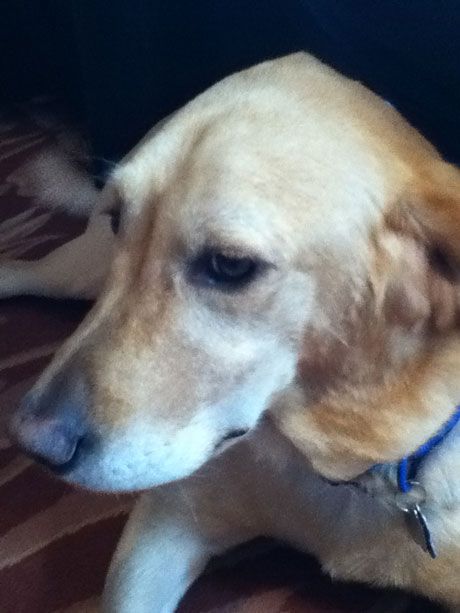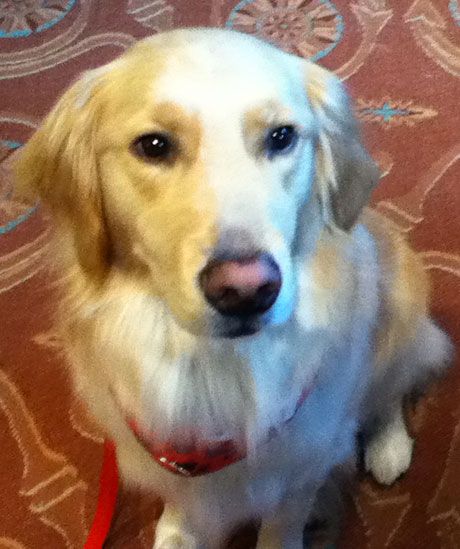Dogs I met at NAVC
One of the upsides of working with veterinarians, as far as I'm concerned, is that when you all get together a few dogs also find their way to the meeting. And this year's NAVC in Orlando, Fla., was no exception. These are the dogs I was lucky enough to meet.
Maywood
Maywood was acting as spokesperson for Southeastern Guide Dogs with his handler Suzy Wilburn. Wilburn is the Training Kennel manager for the organization. She is legally blind, and Maywood is her guide dog. I met Maywood and Wilburn as part of a support effort by Royal Canin. For each token NAVC attendees turned in at the Royal Canin booth, the company donated $1 to Southeastern Guide Dogs.

The Florida-based organization works in 15 states and and pairs more than 70 guide dogs with visually impaired individuals each year. It is one of 9 accredited organizations in the United States.
The dogs typically spend 14 months in a volunteer home during their puppy training, and during that time, their puppy families expose them to all kinds of stimuli to prepare them for the next phase of training. At any given time, Wilburn says, there are 250 puppies being raised and 86 in training.
It costs about $60,000 to train each dog. The organization is focusing on four breeds: Labradors, Golden Retrievers, Smooth Coat Collies, and Laborador-Golden Retreiver mixes. www.guidedogs.org
Blondie
Blondie was at NAVC to help raise awareness for Canine Companions for Independence. She works in a school with children who have special education needs. Her handler, Carol Kallina, teaches Spanish, and Blondie responds to many of her commands when given in Spanish as well as in English. Blondie is a five-year-old Golden Retriever-Labrador mix, and she knows more than 40 commands.

Kallina says that typically, puppies spend 13 to 18 months with puppy raisers and then go through six to nine months of additional training. Then they are matched with an adult or child with a disability. The group trains four types of assistance dogs:
- Service dogs assist adults with physical disabilities by performing daily tasks
- Hearing dogs alert the deaf and hard of hearing to important sounds
- Facility dogs work with a professional in a visitation, education, or healthcare setting
- Skilled companions enhance independence for children and adults with physical, cognitive, and developmental disabilities.
Woodby
Woodby attended NAVC as the mascot for the certificate program in Canine Physical Rehabilitation at the University of Tennessee. He is psychiatric service dog, who provides emotional support, reminds his human partner to take medications, and will get him up if he's in bed for more than seven or eight hours. There are now between 300 and 400 psychiatric service dogs working in the United States.
www.utcaninerehab.com

Josh
Josh stars in a book written by veterinarian Dr. Randy Lange that describes Josh's first hospital visit. Through his experience, Josh helps children face their own hospital experiences. You can buy the book for one special child or learn more about how to help childrens' hospitals with a donation program at
Joshandfriends.com
. The organization also offers a gift set that comes with a copy of the book and a plush Josh that can go along on a child's hospital visit and reassure him or her that everything will be OK.

The live, fuzzy, real Josh is two-and-a-half and recently became certified as an International Therapy Dog. At home in Knoxville, Tenn., Josh regularly visits East Tennessee Children's Hospital. He was also a big hit with children walking by at NAVC, where he worked to raise awareness about The Josh Project, a national effort to support donations of gift sets to childrens' hospitals. Partner organizations in this effort include The Children's Miracle Network, The American Legion Family, and The American Veterinary Medical Association, and the Student Chapters of the American Veterinary Medical Association (SCAVMA)..
Bootsie
Bootsie was acting as a "donation dog," raising money and awareness for the Orlando branch of Greyhound Pets of America. greyhoundpetsorlando.org. The group had several greyhounds on site, and the organization's members answered questions from passersby and worked to educate attendees about the suitability of Greyhounds as pets.

Veterinary Heroes: Patricia Kennedy Arrington, DVM, CVFP
December 1st 2024As a leader in 24-hour veterinary care and a champion for women in the field, Patricia Kennedy Arrington, DVM, CVFP, has dedicated her 50-year career to transforming veterinary medicine and inspiring future practitioners.
Read More
Veterinary Heroes: Ann E. Hohenhaus, DVM, DACVIM (Oncology, SAIM)
December 1st 2024A trailblazer in small animal internal medicine, Ann E. Hohenhaus, DVM, DACVIM (Oncology, SAIM), has spent decades advancing the profession through clinical expertise, mentorship, and impactful communication.
Read More
Veterinary Heroes: Patricia Kennedy Arrington, DVM, CVFP
December 1st 2024As a leader in 24-hour veterinary care and a champion for women in the field, Patricia Kennedy Arrington, DVM, CVFP, has dedicated her 50-year career to transforming veterinary medicine and inspiring future practitioners.
Read More
Veterinary Heroes: Ann E. Hohenhaus, DVM, DACVIM (Oncology, SAIM)
December 1st 2024A trailblazer in small animal internal medicine, Ann E. Hohenhaus, DVM, DACVIM (Oncology, SAIM), has spent decades advancing the profession through clinical expertise, mentorship, and impactful communication.
Read More
2 Commerce Drive
Cranbury, NJ 08512
All rights reserved.